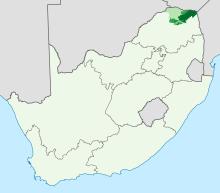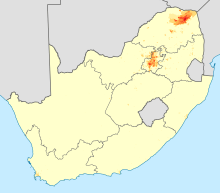Venda language
Venda or Tshivenda, also known as Tshivenḓa or Luvenḓa, is a Bantu language and an official language of South Africa. It is mainly spoken by the Venda people in the northern part of South Africa's Limpopo Province, as well as by some Lemba people in Zimbabwe. The Venda language is related to Kalanga, which is spoken in Zimbabwe and Botswana. During the apartheid era of South Africa, the bantustan of Venda was set up to cover the Venda speakers of South Africa.
| Venda | ||||
|---|---|---|---|---|
| Tshivenḓa | ||||
| Native to | South Africa, Zimbabwe | |||
| Region | Limpopo Province | |||
Native speakers | 1.3 million (2011 census)[1] 1.7 million L2 speakers in South Africa (2002)[2] | |||
Niger–Congo
| ||||
| Latin (Venda alphabet) Venda Braille | ||||
| Signed Venda | ||||
| Official status | ||||
Official language in | ||||
| Language codes | ||||
| ISO 639-1 | ve | |||
| ISO 639-2 | ven | |||
| ISO 639-3 | ven | |||
| Glottolog | vend1245[3] | |||
S.20 (S.21)[4] | ||||
| Linguasphere | 99-AUT-b incl. varieties | |||
 Geographical distribution of Tshivenda in South Africa: proportion of the population that speaks Tshivenda at home.
| ||||
 Geographical distribution of Tshivenda in South Africa: density of Tshivenda home-language speakers.
| ||||
| Person | MuVenda |
|---|---|
| People | VhaVenda |
| Language | Tshivenḓa/Luvenḓa |
| Country | Venda, Vendaland |
According to the 2011 census, Venda speakers are concentrated in the following areas: Makhado Local Municipality, with 350,000 people; Thulamela Local Municipality, with 370,000 people; Musina Local Municipality, with 35,000 people; and Mutale Local Municipality, with 89,000 people. The total number of speakers in Vhembe district currently stands at 844,000. In Gauteng province, there are 275,000 Venda speakers. Fewer than 10,000 are spread across the rest of the country — for a total number of Venda speakers in South Africa at 1.2 million people or just 2.2% of South Africa's population, making Venda speakers the second smallest minority language in South Africa, after the Ndebele language, which number 1.1 million speakers.
Writing system
The Venda language uses the Latin alphabet with five additional accented letters. There are four dental consonants with a circumflex accent below the letter (ḓ, ḽ, ṋ, ṱ) and an overdot for velar ṅ. Five vowel letters are used to write seven vowels. The letters C, J and Q are used only for foreign words and names.
| A a | B b | (C c) | D d | Ḓ ḓ | E e | F f | G g | |
| H h | I i | (J j) | K k | L l | Ḽ ḽ | M m | N n | |
| Ṋ ṋ | Ṅ ṅ | O o | P p | (Q q) | R r | S s | T t | |
| Ṱ ṱ | U u | V v | W w | X x | Y y | Z z |
Unicode
The extra letters have the following Unicode names:
- Ḓ U+1E12 LATIN CAPITAL LETTER D WITH CIRCUMFLEX BELOW
- ḓ U+1E13 LATIN SMALL LETTER D WITH CIRCUMFLEX BELOW
- Ḽ U+1E3C LATIN CAPITAL LETTER L WITH CIRCUMFLEX BELOW
- ḽ U+1E3D LATIN SMALL LETTER L WITH CIRCUMFLEX BELOW
- Ṅ U+1E44 LATIN CAPITAL LETTER N WITH DOT ABOVE
- ṅ U+1E45 LATIN SMALL LETTER N WITH DOT ABOVE
- Ṋ U+1E4A LATIN CAPITAL LETTER N WITH CIRCUMFLEX BELOW
- ṋ U+1E4B LATIN SMALL LETTER N WITH CIRCUMFLEX BELOW
- Ṱ U+1E70 LATIN CAPITAL LETTER T WITH CIRCUMFLEX BELOW
- ṱ U+1E71 LATIN SMALL LETTER T WITH CIRCUMFLEX BELOW
Luṱhofunḓeraru lwa Mibvumo
The sintu writing system Isibheqe Sohlamvu/Ditema tsa Dinoko, known technically in Venda as Luṱhofunḓeraru lwa Mibvumo, is also used for the Venda language.
| ṱala "divorce" |
 [t̪ʼaːɽa] |
tala "draw a line" |
 [tʼaːɽa] |
|---|---|---|---|
Phonology
Venda distinguishes dental ṱ, ṱh, ḓ, ṋ, ḽ from alveolar t, th, d, n, l as well as (like in Ewe) labiodental f, v from bilabial fh, vh (the last two are slightly rounded). There are no clicks; x has the sound of ch in loch or Bach. As in other South African languages like Zulu, ph, ṱh, th, kh are aspirated and the "plain" stops p, ṱ, t, and k are ejective.
There are five vowel sounds: /i ɛ a ɔ u/.
| Bilabial | Labio- dental |
Dental | Alveolar | Post- alveolar |
Palatal | Velar | Glottal | |||||||
|---|---|---|---|---|---|---|---|---|---|---|---|---|---|---|
| plain | pal. | lab. | plain | lab. | pal. | plain | lab. | |||||||
| Stop | ejective | pʼ | pʲʼ | pʷʼ | t̪ʼ | tʼ | tʲʼ | kʼ | ||||||
| aspirated | pʰ | pʲʰ | pʷʰ | t̪ʰ | tʰ | kʰ | ||||||||
| voiced | b | bʲ | bʷ | d̪ | d | dʲ | ɡ | |||||||
| Nasal | m | mʲ | (ɱ) | n̪ | n | ɲ | ŋ | ŋʷ | ||||||
| Lateral | l̪ | (l) | ||||||||||||
| Affricate | ejective | p̪fʼ | tsʼ | tsʷʼ | tʃʼ | |||||||||
| aspirated | p̪fʰ | tsʰ | tsʰʷ | tʃʰ | ||||||||||
| voiced | b̪v | dz | dzʷ | dʒ | ||||||||||
| Fricative | voiceless | ɸ | f | s | sʷ | ʃ | x | h | ||||||
| voiced | β | v | z | zʷ | ʒ | |||||||||
| Rhotic | voiced | r | ||||||||||||
| flap | ɺ | |||||||||||||
| Approximant | j | w | ||||||||||||
A labiodental nasal /ɱ/ sound appears in prenasalised consonant sounds, and /l/ is often used from loanwords. Labiovelar sounds occur as alternatives to labiopalatal sounds and may also be pronounced /pkʰ pkʼ bɡ mŋ/ [5]. Fortition of /ɸ β s ʃ x h l̪ l r w/ occurs after nasal prefixes, likely to [pʰ? b tsʰ tʃʰ kʰ? pʰ d̪ d d b].[6]
| letter(s) | value(s) in IPA | notes |
|---|---|---|
| a | [a], [ɔ] | |
| b | [b] | |
| bv | [b̪v] | |
| bw | [bɣw] or [bj] | Varies by dialect |
| d | [d] | |
| dz | [d͡z] | |
| dzh | [d͡ʒ] | Similar to English "j" |
| dzw | [d͡zw] | |
| ḓ | [d̪] | |
| e | [ɛ], [e] | |
| f | [f] | |
| fh | [ɸ] | |
| g | [ɡ] | |
| h | [ɦ], [h] | Pronounced [h] before e. |
| hw | [ɣw] | |
| i | [i] | |
| k | [kˀ] | |
| kh | [kʰ] | |
| khw | [kʰw] | |
| l | [ɭ] | |
| ḽ | [l̪] | |
| m | [m], [m̩] | M is syllabic [m̩], when the following syllable begins with m. |
| n | [n], [n̩] | N is syllabic when the following syllable begins with n. |
| ng | [ŋɡ] | |
| ny | [ɲ] | |
| nz | [nd͡z] | |
| ṋ | [n̪] | |
| ṅ | [ŋ] | |
| ṅw | [ŋw] | |
| o | [ɔ], [o] | |
| p | [pˀ] | |
| ph | [pʰ] | |
| pf | [p̪f] | |
| pfh | [p̪fʰ] | |
| r | [ɾ] | |
| s | [s] | |
| sh | [ʃ] | |
| sw | [ʂ] | |
| t | [tˀ] | |
| th | [tʰ] | |
| ts | [t͡s] | |
| tsh | [t͡ʃʰ] | |
| tsw | [t͡sw] | |
| ty | [c] | |
| ṱ | [t̪] | |
| ṱh | [t̪h] | |
| u | [u] | |
| v | [v] | |
| vh | [β] | |
| w | [w] | |
| x | [x] | Similar to the ch in Scottish loch. |
| xw | [xw] | |
| y | [j] | |
| z | [z] | |
| zh | [ʒ] | |
| zw | [ʐ] |
Tones
Venda has a specified tone, HIGH, with unmarked syllables having a low tone. Phonetic falling tone occurs only in sequences of more than one vowel or on the penultimate syllable if the vowel is long. Tone patterns exist independently of the consonants and vowels of a word and so they are word tones. Venda tone also follows Meeussen's rule: when a word beginning with a high tone is preceded by that high tone, the initial high tone is lost. (That is, there cannot be two adjacent marked high tones in a word, but high tone spreads allophonically to a following non-tonic ("low"-tone) syllable.) There are only a few tone patterns in Venda words (no tone, a single high tone on some syllable, two non-adjacent high tones), which behave as follows:
| Word | Pattern | After L | After H | Notes |
|---|---|---|---|---|
| thamana | –.–.– | thàmà:nà | thámâ:nà | Unmarked (low) tone is raised after a high tone. That is, the preceding tone spreads. |
| dukaná | –.–.H | dùkà:ná | dúkâ:ná | A preceding high tone spreads but drops before the final high tone. |
| danána | –.H.– | dàná:nà | dánâ:nà | The pitch peaks on the tonic syllable, and a preceding non-adjacent high tone merges into it. |
| phaphána | –.H.– | phàphá:ná | pháphâ:nà | |
| mádzhie | H.– | má:dzhíè | mâ:dzhìè | Initial high tone spreads. With an immediately preceding high tone, that initial tone is lost. (The preceding tone also spreads but not as far.) |
| dákalo | H.–.– | dáká:lò | dákà:lò | |
| khókholá | H.–.H | khókhô:lá | khókhò:lá |
References
- Venda at Ethnologue (18th ed., 2015)
- Webb, Vic. 2002. "Language in South Africa: the role of language in national transformation, reconstruction and development." Impact: Studies in language and society, 14:78
- Hammarström, Harald; Forkel, Robert; Haspelmath, Martin, eds. (2017). "Venda". Glottolog 3.0. Jena, Germany: Max Planck Institute for the Science of Human History.
- Jouni Filip Maho, 2009. New Updated Guthrie List Online
- Poulos, George (1990). A Linguistic Analysis of Venda.
- Jeff Mielke, 2008. The emergence of distinctive features, p 139ff
Sources
- G. Poulos, A linguistic analysis of Venda, 1990.
External links
| Venda edition of Wikipedia, the free encyclopedia |
- Tshivenḓa Grammar Guide by Zach Gershkoff, US Peace Corps (2012).
- PanAfrican L10n page on Venda
- Young kasahorow Dictionary in Venda
Software
- Translate.org.za Project to translate Free and Open Source Software into all the official languages of South Africa, including Venda